|
|
 |
Fiche d'espèce de Copépode |
|
|
Calanoida ( Ordre ) |
|
|
|
Clausocalanoidea ( Superfamille ) |
|
|
|
Stephidae ( Famille ) |
|
|
|
Stephos ( Genre ) |
|
|
| |
Stephos fernandoi Suarez-Morales, Gutiérrez-Aguirre, Cervantes-Martinez & Iliffe, 2017 (F,M) | |
| | | | | | | Ref.: | | | Suarez-Morales & al., 2017 (p.1, Descr. F, M, figs.F, M, Rem.) | 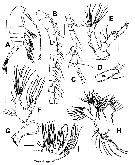 Issued from : E. Suarez-Morales, M. A. Gutiérrez-Aguirre, A. Cervantes-Martinez & T. Iliffe in ZooKeys, 2017, 671. [p.4, Fig.1]. Female (from 20°27'3.2''N, 86°59'14.4''W): A, habitus (lateral); B, A1 (segments 1-16); C, A1 (segments 17-24); D, A1 (segment 24 showing apical process; E, A2; F, Md (palp); G, Md (gnathal base); H, Mx1; I, Mx2. Scale bars: A = 100 µm; D: 10 µm; B, C, E-I: 20 µm. Nota: - Cephalosome and 1st pedigeous somite separate, 4th and 5th fused. - Prosome with posterolateral corners rounded, moderately produced, symmetrical. - Rostrum weakly developed, represented by small medial expansion, rostral points absent. - Urosome 4-segmented, representing 31% of total body length. - Genital double-somite relatively long, almost 40% of urosome, barrel-shaped, weakly expanded mid-ventrally symmetrical. Single gonopore opening ventrally at proximal 1/3 of somite; adjacent ventral surface of somite ornamented with 4 slender spiniform elements inserted at each side of simple, transverse genital operculum. - Anal somite shortest of urosome , subrectangular, about 10% of urosome length, cuticular ornamentation absent on dorsal and ventral surfaces. - A1 24-segmented, reaching posterior margin of preanal somite. One of the setal elemnts on segment 12 spiniform. Distal segment with apical acute process present in some specimens (fig.1, D). - A2 biramous, exopod longer than endopod. Endopod 2-segmented, distal portion of terminal segment with 2 lobes, proximal lobe with 8 setae, distal lobe with single short, lateral seta plus 5 long terminal setae. Exopod indistinctly 7-segmented. - Md with gnathobase armed with 4 large monocuspid ventral teeth plus 3 smaller bicuspid teeth, dorsal monocuspid tooth, and short dorsal seta. Serial teeth distinctly separated from large ventralmost tooth by diastema. Palp biramous, basis robust, armed with 4 subequal setae inserted on medial margin. Endopod short, 2-segmented; proximal segment with 2 short and 1 long setae, outer margin protuberant; distal segment subrectangular, with 10 setae, 1 reduced. Exopod indistinctly 5-segmented, armed with 1, 1, 1, 1, 2 setae. - Mx1 with praecoxal arthrite bearing 9 spiniform marginl setae. Coxal epipodite with 9 setae, coxal endite with 2 setae. Basis with proximal endite bearing 4 setae, distal basal endite armed with 5 setae. Endopod reduced, not articulated to basis, indistinctly 3-segmented, proximal segment with 4 setae, 2nd segment with 2 setae, distal segment with 6 setae. Exopod oblong, with 10 subequal setae. - Mx2 indistinctly 6-segmented including precoxa, coxa, allobasis and 3-segmented endopod. Free endopodal segments armed with 1, 1, 3 setae. - Mxp indistinctly 9-segmented, precoxa and coxa partially fused, precoxa unarmed, with cluster of spinules. Endopod 6-segmented, armed with 2, 4, 4, 2, 2, 4 setae.
|
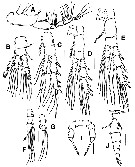 Issued from : E. Suarez-Morales, M. A. Gutiérrez-Aguirre, A. Cervantes-Martinez & T. Iliffe in ZooKeys, 2017, 671. [p.6, Fig.2, A-G, I-J]. Female: A, Mxp; B, P1; C, P2: D, P3; E, P4; F, P1 exopod (another specimen showing reduced outermost apical spine, arrow); G, P1 endopod (another specimen); I, P5 (anterior view); J, 5th pedigerous somite and urosome (lateral view). A-I: 20 µm; J, 50 µm.I: 20 µm; J: 50 µm. Nota: P5 reduced, symmetrical, uniramous, 2-segmented with proximal segment cylindrical, distal segment proximally globose, forming long spiniform bipinnate apical process.
|
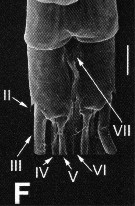 Issued from : E. Suarez-Morales, M. A. Gutiérrez-Aguirre, A. Cervantes-Martinez & T. Iliffe in ZooKeys, 2017, 671. [p.10, Fig.4, F]. Female: F, caudal rami showing caudal setae II-VII (ventral view). Scale bar: 10 µm. Nota: Caudal rami subrectangular, symmetrical, length/width ratio = 1.6-1.7, armed with 6 caudal setae (II-VII). - Inner margin naked except for displaced dorsal seta (VII) inserted on proximal 1/4 of inner margin, seta reaching beyond distal margin of ramus. - Caudal seta I absent, seta II reduced, inserted near base of seta III. Terminal setae III-VI well developed. - All ramal setae biserially plumose.
|
 Issued from : E. Suarez-Morales, M. A. Gutiérrez-Aguirre, A. Cervantes-Martinez & T. Iliffe in ZooKeys, 2017, 671. [p.8, Table I]. Female: Armature formula of swimming legs P1-P4. Roman numerals indicate spines and Arabic numerals are setae.
|
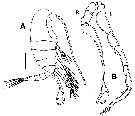 Issued from : E. Suarez-Morales, M. A. Gutiérrez-Aguirre, A. Cervantes-Martinez & T. Iliffe in ZooKeys, 2017, 671. [p.8, Fig.3]. Male (from 20°27'3.2''N, 86°59'14.4''W): A, habitus (lateral view); B, P5 (L = left ramus ; R = right ramus). A: 100 µm; B: 50 µm. Nota: - Rostrum as in female. - Urosome 5-segmented, representing 32% of total body length. 1st urosomite symmetrical. - Anal somite shortest. - Caudal rami relatively short, symmetrical, caudal setae as in female. - P5 uniramous, asymmetrical. Left leg 5-segmented, about as long as right counterpart; proximal segment widest of ramus, with inner margin expanded. 2nd, 3rd and 4th segments elongate, 4th with triangular plate on distomedial angle; distal segment with 3 terminal lamellae tapering distally plus subdistal subtriangular process, and with short seta inserted proximally on medial margin. - Right leg 4-segmented; 1st and 2nd segments cylindrical, robust, unarmed; 3rd segment elongate and tapering; 4th segment very slender and bifurcating distally into ''C''-shaped structure furnished with 6-8 peg-like elements along bifurcation. End of subdistal process acute, opposite end with apical leaf-like expansion.
|
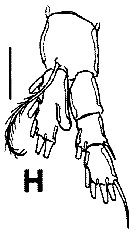 Issued from : E. Suarez-Morales, M. A. Gutiérrez-Aguirre, A. Cervantes-Martinez & T. Iliffe in ZooKeys, 2017, 671. [p.6, Fig.2, H]. Male : P1.
| | | | | NZ: | 1 | | |
|
Carte de distribution de Stephos fernandoi par zones géographiques
|
| | | | Loc: | | | E Mexico (Cozumel Island, anchialine cave of Cenote Tres Potrillos)
Type locality: 20°27'3.2'' N, 86°59'14.4'' W | | | | N: | 1 | | | | Lg.: | | | (1310) F: 0.475; M: 0.493; {F: 0.475; M: 0.475} | | | | Rem.: | Por Suarez-Morales & al. (p.1) , the new species is clearly distinguished from its congeners by the characters: male left P5 with 3 terminal lamellae plus subdistal process, tight P5 with distal row of peg-like elements; female P5 with single long, acute apical process genital double-somite with 2 rows each of 4 long spinules adjacent to operculum; P2-P4 with articulated setae.
The introduction of stephid copepods in the region may be a relatively recent event derived from colonization of benthopelagic ancestral forms and subsequent invasion o,to cave habitats. | | | Dernière mise à jour : 11/07/2017 | |
|
|
 Toute utilisation de ce site pour une publication sera mentionnée avec la référence suivante : Toute utilisation de ce site pour une publication sera mentionnée avec la référence suivante :
Razouls C., Desreumaux N., Kouwenberg J. et de Bovée F., 2005-2025. - Biodiversité des Copépodes planctoniques marins (morphologie, répartition géographique et données biologiques). Sorbonne Université, CNRS. Disponible sur http://copepodes.obs-banyuls.fr [Accédé le 31 décembre 2025] © copyright 2005-2025 Sorbonne Université, CNRS
|
|
 |
 |








